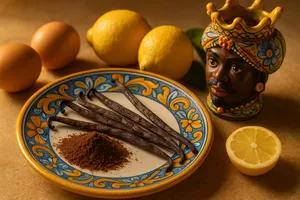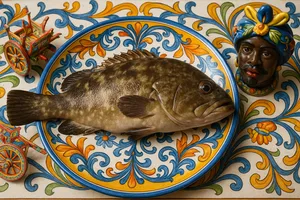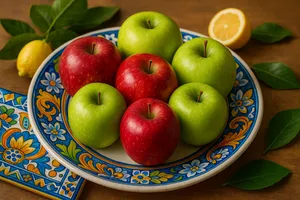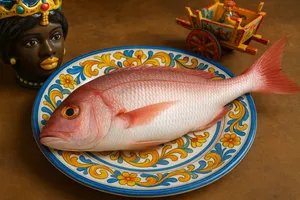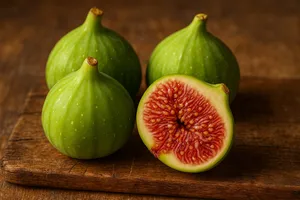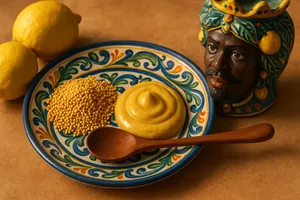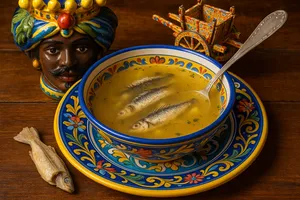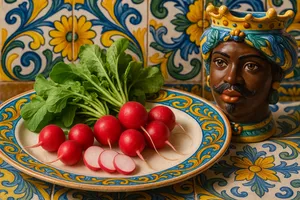Overview
Carob, called in Sicilian “carrubbi” or “sciusceddi”, is the fruit of the carob tree (Ceratonia siliqua), an evergreen species symbolic of the Mediterranean landscape and particularly widespread in Sicily. These dark, elongated and flattened pods, with their sweet and aromatic pulp, are a traditional ingredient of Sicilian cuisine, eaten fresh as a natural snack or transformed into flour with multiple applications in pastry and gastronomy.
In Sicilian tradition, carob has always played an important role not only as food but also as an economic resource. Its cultivation was particularly widespread in the coastal and hilly areas of the island, where century-old carob trees create evocative landscapes and offer shade and shelter to animals. The gastronomic rediscovery of this ancient fruit is bringing carob back to Sicilian tables with modern interpretations that highlight its nutritional properties and unique flavour.
Characteristics
Carob appears as elongated pods, slightly curved, dark brown when ripe, ranging from 10 to 30 centimetres in length and about 2–3 centimetres in width. The ripe fruit has a hard, leathery exterior, while inside it contains a sweet, reddish-brown, viscous and highly aromatic pulp surrounding the hard, glossy seeds.
The flavour is sweet, intensely sugary with notes of caramel, dates and molasses, slightly astringent with a chocolate-like aftertaste. The aroma is characteristic, sweet and slightly wine-like. Fresh carob has a waxy texture and is difficult to chew due to the hardness of the pod, while the inner pulp is sticky and very sweet.
Carob flour, obtained by grinding the dried pulp, appears as a fine light-brown powder with a sweet aroma reminiscent of cocoa but with more caramelised notes.
Seasonality
In Sicily, carob ripens between August and October. During these months, the pods turn from green to dark brown, indicating full ripeness and maximum sweetness. Traditional harvesting is done by shaking the trees with long poles, causing the ripe fruit to fall onto cloths spread on the ground.
Once sun-dried, carob keeps for months and may be used all year round. Carob flour is available in every season, produced from stored and dried fruit.
Traditional use
In traditional Sicily, carob had multiple uses.
Natural snack
Fresh carob was eaten by children as a natural snack, broken with the teeth to suck the sweet inner pulp. It was a simple but nutritious treat, freely available to those living in the countryside.
Animal feed
Traditionally, carob was primarily used as animal feed, particularly for horses, mules and livestock. Its nutritional properties made it a valuable food, especially during periods of forage scarcity.
Chocolate substitute
During wartime and periods of famine, carob flour was used as a substitute for cocoa to prepare sweet hot drinks, although the flavour is quite different.
Modern use in the kitchen
Today carob and carob flour are experiencing a gastronomic revival.
Flour for sweets
Carob flour is used to prepare biscuits, cakes, creams and various desserts. It has a natural sweetening power that allows sugar reduction in recipes. It is naturally gluten-free and suitable for coeliacs.
Beverages
Carob flour dissolved in hot milk creates a sweet and nutritious drink, an alternative to chocolate. A traditional Sicilian carob liqueur is also made, aromatic and sweet.
Carob syrup
A dense and very sweet syrup is obtained from the pulp of carob, used as a natural sweetener or diluted in water as a refreshing drink. It is particularly appreciated in summer.
Baked goods
The flour is added to bread and baked products to give a dark colour and a distinctive sweet flavour, as well as to enhance nutritional value.
Flour preparation
Carob flour is prepared by completely sun-drying the pods, removing the very hard seeds, and then finely grinding the dried pulp. The traditional process required days of drying under the Sicilian sun and milling with stone grinders.
Today, carob flour is commercially available and industrially produced, but some Sicilian artisanal producers continue to prepare it according to traditional methods, obtaining a superior product.
Storage
Dried whole carob keeps for many months in a cool and dry place, protected from moisture. When well stored, it keeps almost indefinitely.
Carob flour should be stored in airtight containers, away from light, heat and humidity. It keeps for 6–12 months, although it may lose part of its aroma over time. It is important that it does not absorb moisture, which would cause it to clump.
Nutritional properties
Carob is very nutritious and rich in natural sugars (about 40–50% of its weight), mainly sucrose, glucose and fructose. It contains about 200–250 calories per 100 grams of dried pulp.
It is rich in fibre (around 40%), which promotes intestinal transit and gives prebiotic properties. It contains important minerals such as calcium, iron, magnesium and potassium, along with B vitamins and vitamin E.
Carob is naturally free of caffeine and theobromine, unlike cocoa, making it suitable for those sensitive to these substances. It contains tannins with astringent and antioxidant properties. In Sicilian folk medicine, carob flour was used as a remedy for intestinal disorders, especially diarrhoea.
Buying tips
Whole carob pods should be uniformly dark brown, well dried, without mould or spots. The pod should be hard but not so dry that it crumbles. The aroma should be sweet and pleasant.
Carob flour should have a uniform light-brown colour, fine and even texture, and a sweet, pleasant aroma. Always check the expiry date and prefer Sicilian products that guarantee quality. Organic flour is preferable to avoid residues of treatments.
Curiosities
The name “carat”, the unit of measurement for precious stones, derives from carob seeds which, having a remarkably uniform weight (about 200 milligrams), were used in antiquity as a standard for weighing gold and gems.
In Sicily, an old saying goes: “Cu havi un carrubbu, havi un tesoru” (Whoever has a carob tree has a treasure), highlighting the economic value of these trees which produced marketable fruit and valuable timber.
During the Second World War, when sugar and chocolate were hard to find, Sicilian families prepared a hot drink with carob flour, milk and a pinch of cinnamon, called “ciucculatta di puvireḍḍi” (the poor man’s chocolate), which warmed and nourished during cold winter evenings.
Sicilian carob trees can live for hundreds of years. Monumental specimens exist across the island, some over 500 years old, venerated as symbols of longevity and resilience.
In Modica, where the tradition of cold-worked chocolate thrives, some master chocolatiers are experimenting with adding carob flour to Modica chocolate, creating bars with a unique flavour that combine two Sicilian excellences.


